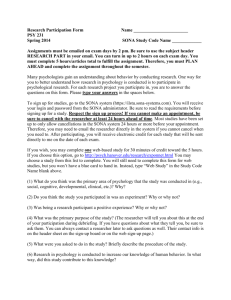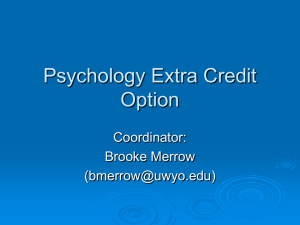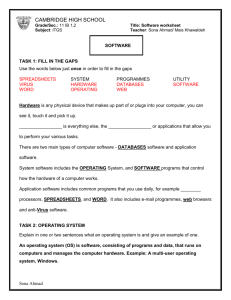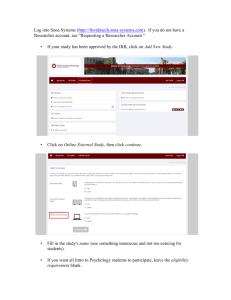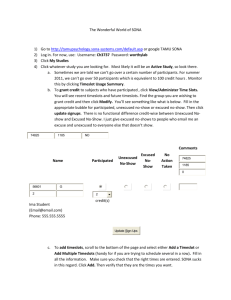Psychology Research Participation System
advertisement
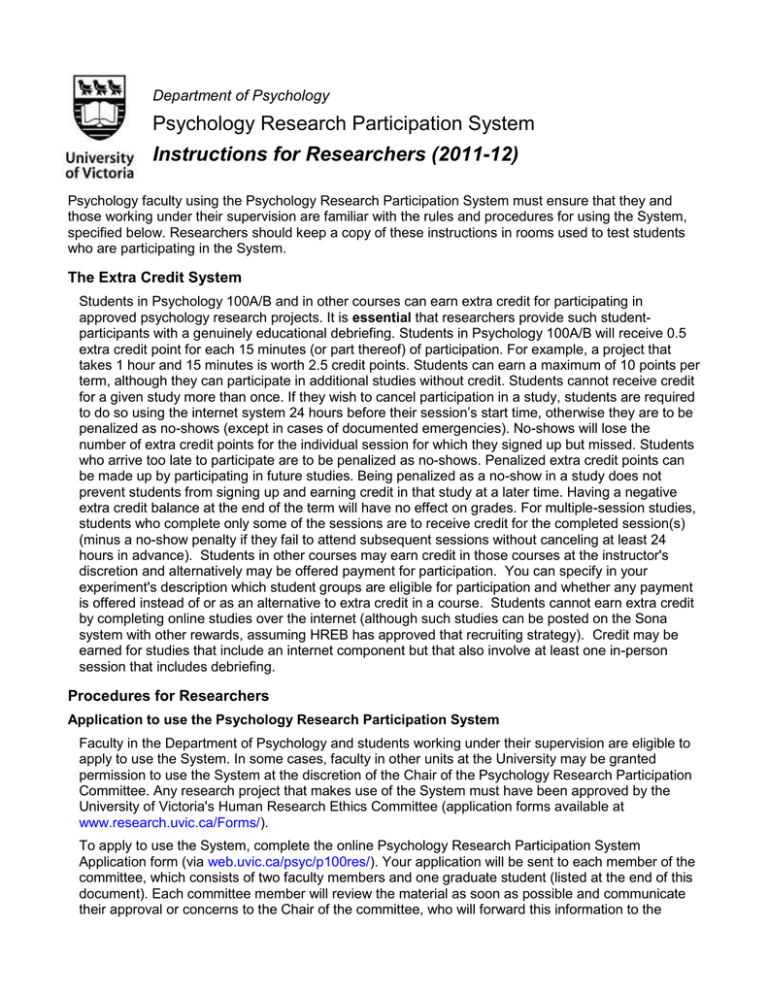
Department of Psychology Psychology Research Participation System Instructions for Researchers (2011-12) Psychology faculty using the Psychology Research Participation System must ensure that they and those working under their supervision are familiar with the rules and procedures for using the System, specified below. Researchers should keep a copy of these instructions in rooms used to test students who are participating in the System. The Extra Credit System Students in Psychology 100A/B and in other courses can earn extra credit for participating in approved psychology research projects. It is essential that researchers provide such studentparticipants with a genuinely educational debriefing. Students in Psychology 100A/B will receive 0.5 extra credit point for each 15 minutes (or part thereof) of participation. For example, a project that takes 1 hour and 15 minutes is worth 2.5 credit points. Students can earn a maximum of 10 points per term, although they can participate in additional studies without credit. Students cannot receive credit for a given study more than once. If they wish to cancel participation in a study, students are required to do so using the internet system 24 hours before their session’s start time, otherwise they are to be penalized as no-shows (except in cases of documented emergencies). No-shows will lose the number of extra credit points for the individual session for which they signed up but missed. Students who arrive too late to participate are to be penalized as no-shows. Penalized extra credit points can be made up by participating in future studies. Being penalized as a no-show in a study does not prevent students from signing up and earning credit in that study at a later time. Having a negative extra credit balance at the end of the term will have no effect on grades. For multiple-session studies, students who complete only some of the sessions are to receive credit for the completed session(s) (minus a no-show penalty if they fail to attend subsequent sessions without canceling at least 24 hours in advance). Students in other courses may earn credit in those courses at the instructor's discretion and alternatively may be offered payment for participation. You can specify in your experiment's description which student groups are eligible for participation and whether any payment is offered instead of or as an alternative to extra credit in a course. Students cannot earn extra credit by completing online studies over the internet (although such studies can be posted on the Sona system with other rewards, assuming HREB has approved that recruiting strategy). Credit may be earned for studies that include an internet component but that also involve at least one in-person session that includes debriefing. Procedures for Researchers Application to use the Psychology Research Participation System Faculty in the Department of Psychology and students working under their supervision are eligible to apply to use the System. In some cases, faculty in other units at the University may be granted permission to use the System at the discretion of the Chair of the Psychology Research Participation Committee. Any research project that makes use of the System must have been approved by the University of Victoria's Human Research Ethics Committee (application forms available at www.research.uvic.ca/Forms/). To apply to use the System, complete the online Psychology Research Participation System Application form (via web.uvic.ca/psyc/p100res/). Your application will be sent to each member of the committee, which consists of two faculty members and one graduate student (listed at the end of this document). Each committee member will review the material as soon as possible and communicate their approval or concerns to the Chair of the committee, who will forward this information to the Psychology Research Participation System—Researcher Instructions researcher. If a project was approved in a prior academic year, a renewal application must be filed for it to be reactivated for the current academic year. The application form requires the following information: (a) A short, unique, memorable name for the study. This is to help students keep track of the studies in which they have taken part and is used by the System to manage sign-ups and record credit. (b) UVic ethics approval number. UVic ethics approval must be obtained before applying to use this System. (c) Name of faculty sponsor and (if applicable) name(s) of student(s) or assistant(s) conducting the study. (d) Location of the study and a telephone contact number. If the location of the study or telephone contact changes, please inform the Psychology Research Participation Committee Chair. (e) A UVic e-mail address (ending in @uvic.ca) for the designated experimenter is required. This address is used for establishing the project in the sign-up system. A password allowing the experimenter to log into the system to post sign-up times and assign student credit will be emailed to this address. (f) Expected duration of the session (including time for an explanation of the study at the end of the session) and number of credit points. 0.5 credit point is assigned for each 15 minutes (or part thereof) of participation. For example, a session requiring one hour and 15 minutes is 2.5 credits. Researchers may also offer nominal payments for participation, such that students have the option of participating for credit OR for pay (and other members of the community can sign up for pay); if payment is offered, the amount (e.g., $5/hr) should also be indicated. (g) A one- or two-sentence description of the study that will be used on the sign-up site. This description should accurately convey the nature of what the student will be asked to do in the study. (h) Any restrictions on who can sign up for the study (e.g., right-handed people only). Researchers are strongly encouraged to be as inclusive as possible so as to provide all students with ample opportunities to participate in research projects for bonus points. If you want to restrict participation to PSYC 100A/B students you can do this in your experiment description at the Sona site. (i) A brief description, written for the Committee, of the procedure involved in the study, including the independent and dependent variables (if applicable) and hypotheses being tested (not required for renewal projects). This description should be about 200 words in length. (j) A written explanation of the purpose of the study (not required for renewal projects). This explanation should summarize the debriefing students will receive after participation. The text can be either a script that the researcher will follow when explaining the study or a written document that the student will be offered after completing the study. This is an important component of the application because it indicates that an intelligible explanation will be given to students, thus fulfilling the educational objective of this program. Rather than simply handing students a debriefing sheet researchers must schedule time at the end of the session to talk to students about the objectives of the study. (k) Submission of the application means that the sponsoring faculty member agrees to take responsibility for appropriate use of the Psychology Research Participation System by all those involved with the project. After approval is obtained The Chair of the Committee will inform you as to whether your application is approved. Upon receiving approval, you can use the Sona experiment management system (uvic.sona-systems.com/) 2 Psychology Research Participation System—Researcher Instructions to begin posting and managing sign-ups for your experiment. To do so, you will need a researcher account on the Sona system. To request a researcher account, send an e-mail message to the system coordinator (p100res@uvic.ca). Your User ID for this account will be the first part of the UVic e-mail address (the part prior to @uvic.ca) that you entered on your application. Your password will be e-mailed to that e-mail address. The password will be a long string of digits, but you can change it once you log into the system (by going to the “My Profile” section once you are logged into the system). If you are running multiple experiments, you will access all of them through this one User ID. Therefore, if you already are running an approved experiment, any subsequent experiments that you run will be managed with your established User ID. You will also need to obtain copies of (a) the Record of Participation form and (b) the Receipt/Evaluation form that is to be given to each participant in your study. These forms are available online at web.uvic.ca/psyc/p100res/ You will need to print the forms yourself. Using the Sona Experiment Management System The information below provides you with the basic information you need to use the Sona experiment management system. Full documentation in PDF format is available at: http://web.uvic.ca/psyc/p100res/SonasystemV2.74.pdf Information relevant to researchers begins on p. 21 of this Sona documentation. 1. Creating your study Go to uvic.sona-systems.com and enter your User ID and password. To create a new study, click on "Add New Study" (full details are provided beginning on p. 28 of the Sona documentation). Fill in the required information, including the approved name of your study (it is critical that you use only the approved study name). Enter in the “Short Description” the description that was provided on your application for approval of this study. End this description with the contact telephone number for the study (e.g., Contact: 721-7777) that students may use to cancel appointments. Provide more complete information in the “Long Description” section. In the “Eligibility Requirements” section, you may specify student restrictions (e.g., bilingual students only). In addition, each student will have completed a pretest profile that requires the student to indicate gender, year of birth, handedness, whether English is their first language, whether they are a fluent speaker of English, and whether they have normal colour vision. After adding your study, you can go back to view it (click on "view and edit" under the My Studies heading and select the relevant study) and you will see a section called "Pretest Restrictions." You can add restrictions based on pretest responses here (see p. 42 in the Sona documentation). “Duration”. Specify the duration of the session (default is 30 minutes). The Sona system allows for specification of only a single value for session duration (and for associated credit) for a single study. At present there is no way in the Sona system to assign a variable amount of credit as a function of actual session length. Any completed session will be assigned the amount of credit you specify here. Therefore, if your study sessions have the potential to require varying amounts of time for different subjects, you will need to estimate the longest duration that is reasonable to expect and base your session duration and amount of credit (one credit per half hour) on that estimate. Any student who completes your study will be granted that amount of credit, even if their session turns out to take less time than expected. If you encounter cases in which a student takes more time than your maximum, there is a mechanism for granting additional credit. In these rare instances, you can manually grant an appropriate amount of credit (see p. 73 and following of the Sona documentation). “Preparation”. Enter any advance preparation the subject must do prior to participation. “Credits/Pay”. One credit for each half hour of participation is to be assigned. No IRB approval code is needed, since your project will have received approval from the UVic ethics committee prior to be submitted for approval by the Psychology Research Participation Committee 3 Psychology Research Participation System—Researcher Instructions (the approval number is required on the application form). “Active Study”. Click “Yes”. In the “Prerequisites” section, you may specify that students complete a specific study before participating in the one you are adding. This is a good method for setting up studies requiring more than two sessions (the current version of the Sona system has an option for setting up studies that have exactly two sessions; see p. 28 in the documentation). For multiple-session studies involving more than two sessions, the simplest option is to schedule only the first and last sessions using the Sona system, and to schedule the other sessions outside the system. Total credit for participating in such a study would then be split between the two sessions scheduled in the Sona system. An explanation of the multiple-session nature of such a study would be included in the “Long Description” section of the posting on the Sona system. Note that if a student completes some but not all sessions and wishes to terminate participation, he or she must receive credit for the session time that was completed. The "Course Restrictions" section allows you to specify whether only students from PSYC 100A/B or only students from other courses may participate. The “Disqualifiers” section allows you to exclude students who have already participated in certain other studies (perhaps because those studies are too similar to the one you are now adding). “Sign-up Password”. We do not issue passwords to students for specific studies. Indicate whether this is a web-based study. If so, you may need to provide the URL for the study web site (this depends on whether you study is administered by the Sona system). See the Sona documentation for information on setting up web-based studies. The final section of this form is for use with studies that involve exactly two sessions. Click the “Add This Study” button when you are ready. You can edit it later by clicking on "view and edit" under the “My Studies” heading (see "Updating a Study" on p. 40 of the Sona documentation) and selecting the desired study. You can also add restrictions based on student responses to the Pretest as explained above. Once you have completed this form, e-mail the Committee Chair at p100res@uvic.ca to request that your study be made visible to students. After making your study visible to students, the Chair with then contact you to indicate that you may now begin posting time slots for your study. Be sure that you logout at the end of each Sona session by clicking the “Logout” button near the upper right corner of the Sona window. 2. Posting time slots (See p. 63 and following in the Sona documentation for more information.) To post testing sessions, or time slots, to allow students to sign up for your study, log onto the Sona system and go to the “My Studies” heading and click on “view, add, or change timeslots”. Then, under the “View” column for the desired study, click on "Timeslots". You will see a list of existing time slots and you can click on “Add A Timeslot” to add more. Note that you will see an option to add multiple time slots at once. For each time slot you add, default information is initially displayed, but can be modified (except for the End Time, which is fixed by the Start Time that you designate and by the session duration that was specified when you set up your study). Be sure all relevant information, including location is entered. 3. Granting credit and reporting no-shows If a student wishes to terminate participation prior to completion of a study, this wish must be honoured. Credit for the time completed is to be given if the student has a valid reason for terminating participation (e.g., becoming ill, finding some aspect of the procedure unpleasant). All students must 4 Psychology Research Participation System—Researcher Instructions be offered an explanation of the purpose of the study, even if they terminate their participation prematurely. Students who complete sessions normally are to receive full credit for those sessions. If a student fails to show up for an appointment without canceling at least 24 hours in advance, enter the student's name on the Record of Participation Form and write the phrase "No show" and the penalty in the credit column (e.g., for a 1-hour study, "No Show -2") and record the penalty in the Sona experiment management system (see below). Exceptions are to be made in cases of documented emergency (e.g., sudden illness) and other situations beyond the student's control. In such cases, the student receives neither credit nor penalty. If a student arrives too late to participate, then that student is to be penalized as a no-show. When a student completes a session, print on the Record of Participation Form the student's name and registration number, number of credit points earned, and date of participation. Complete a receipt form and give it to the student before she or he leaves the study. The receipt form includes evaluation questions that the student may complete in private after leaving the study if he or she wishes. The student is to retain the receipt and put the optional anonymous evaluation questionnaire in the mail box beside the Psychology 100 office (Cornett A250). The Sona system is set up so that students who have signed up for a study are automatically granted credit for participation overnight, after the session time, unless some action is taken by the researcher prior to that time. This is a convenience, because it means that researchers do not need to enter credit for normally completed sessions. But an entry does need to be made if the student is a noshow. In such cases you should make an entry for the student within a few hours of the testing session, otherwise the student will be automatically credited for completion of the session. Although you can correct this after the fact, problems may arise. To make an entry, log into the Sona system at uvic.sona-systems.com and go to the “My Studies” section (see p. 70 in the Sona documentation for details on granting credit). You can click on the heading “View Your Uncredited Time Slots” to see a list of time slots with student sign ups that have not yet been granted credit. You can then click the “View” button for a particular student to either grant credit or classify the student as a no-show. Alternatively, after going to the “My Studies” section and click on “Timeslots” for the study. This will display a list of time slots. Click the “Modify” button for any time slot for which you wish to make an entry (e.g., grant credit, classify as no-show). Be sure to click the “Update Sign-Ups” button for each entry so that the change will take effect. 4. Record keeping It is your responsibility to ensure that students receive credits (or penalties) via the Sona system in a timely manner. Also, keep the Record of Participation forms 100% up-to-date and save them until 3 months after the term is completed (then have them confidentially shredded). 5. Problems If a student arrives for a session but does not meet restrictions that were clearly stated on the study description (e.g., bilingual) or has already participated in the study, you are entitled to cancel the appointment and not provide credit to the student. In this case, you will make a manual entry in the Sona system, selecting the option labeled “No show (No penalty)”, so that the student neither receives credit nor is penalized (see section 3 above). Special allowances, however, are to be made for students with disabilities, who should be allowed to experience as much of the study as possible and receive the standard explanation of the purpose of the study and full credit for participation. Students are entitled to receive the full credit points for a session if the researcher fails to keep the appointment or cancels with less than 24 hours notice. In these cases the student is to report to the Committee Chair as soon as possible, and the Chair will investigate. To allow the student to participate in the study at a later time for more credit, the entry in the Record of Participation form and the receipts given to students in these cases will have an explanation entered beside the project code name. Full credit for participation will also be given in cases in which unforeseen events prevent researchers from completing a session with a student (e.g., equipment failure). If the researcher 5 Psychology Research Participation System—Researcher Instructions judges that the student cannot be a valid participant in the study at a later time, then the student should receive the standard debriefing. If, however, circumstances allow the student to sign up to participate in that project at a later time, then the researcher may manually sign up the student for another time. To do this, the researcher should agree on a time slot with the student, then manually sign the student into that slot following the instructions on p. 69 of the Sona documentation. If you are uncertain about how to handle a situation involving the Psychology Research Participation System, contact the Chair of the Committee. 6. Once your study is finished When data collection for the entire study is complete, please go into the Sona experiment management system and go to the “My Studies” section. Select your completed study and go to the bottom of the display. Select the “Change Study Information” option and go to the bottom of the resulting display. In the “Active Study” section, click the “No” option to deactivate your study. Be sure to inform the Committee Chair that your study has been deactivated. Committee Members The members of the Psychology Research Participation Committee for 2011-12 are: Michael Masson (Chair) Kim Kerns (Faculty member) Iris Gordon (Graduate Student member) Last revision: January 2012 6
